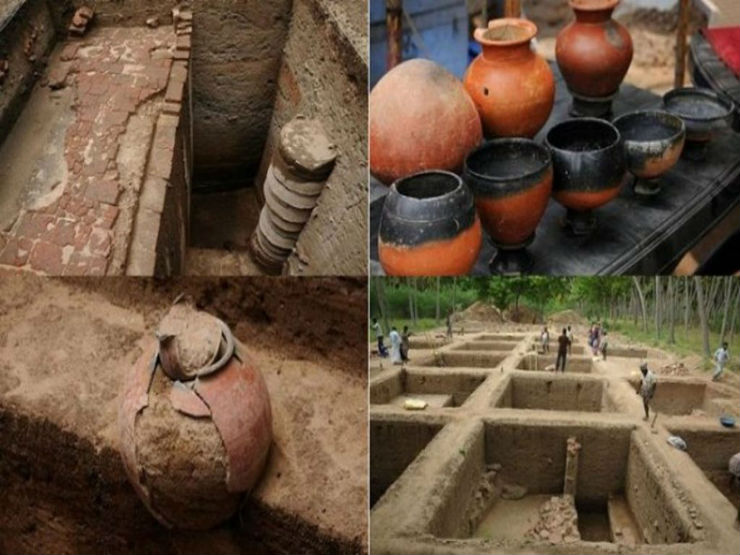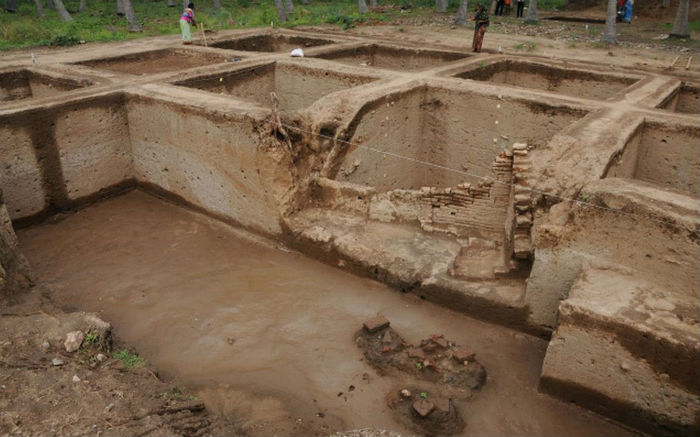 Keezhadi is a village situated on the banks of River Vaigai in Thiruppuvanam Taluk, Sivaganga District. It is located at 9.51° 29' N to 78.11° 69' E, which is about 13 km southeast of Madurai. Keezhadi is bounded by Manalur to the East, Konthagai to the West, Agaram to the South and River Vaigai to the North.
Keezhadi is a village situated on the banks of River Vaigai in Thiruppuvanam Taluk, Sivaganga District. It is located at 9.51° 29' N to 78.11° 69' E, which is about 13 km southeast of Madurai. Keezhadi is bounded by Manalur to the East, Konthagai to the West, Agaram to the South and River Vaigai to the North.
In Keezhadi, an age-old human settlement has been discovered by the Archeological Survey of India (ASI) a few years ago. This 110-acre ancient Tamil Settlement was excavated initially by the ASI in the years 2014-15 and 2015-16 under Superintending Archaeologist K. Amarnath Ramakrishna, and later in 2016-17 under P.S. Sriraman. These excavations unearthed thousands of articles of archaeological significance and show new light on ancient Tamil Life and Culture.
In the years 2017-18 and 2018-19, Tamil Nadu Archaeological Department (TNAD) undertook the excavations in two phases and unearthed thousands of artifacts. An abstract on these two phases of excavations has been published by the TNAD. However, the Archaeological Survey of India has not made any data public on the excavations conducted earlier.
The artifacts discovered by the Tamil Nadu Archaeological Department include Black and Terracotta Pot Tiles, Roulette pot tiles, Gold Ornaments, Copper Objects, Parts of Iron tools, Terracotta Gamesmen (Chess Coins), Ear Ornaments and agate beads. Besides, brick building structures, a ring well, drainage structures and roof tiles were also found in Keezhadi.
Tamil Nadu Archaeological Department has sent six samples from the artifacts to Beta Analytical Laboratory, Florida in the USA for Carbon Dating. From one of the samples, taken at a depth of 353 cm in the excavation site, it is found that Keezhadi Civilization dates back to 580 BCE. Hence, it is certain that the Tamils lived in an Urban Civilization 2600 years ago, i.e., 6th Century BCE. This age corresponds to Sangam Era in literature.
Buildings and Building Materials
A wall of about 13 m length in three lines was found at Keezhadi, in which two sizes of bricks were used for construction. One is of 38 X 23 X 6 cm and another is of 38 X 26 X 6 cm. The building was constructed using sand, lime and bricks and the Ground floor was built with fine clay in addition to bricks.
Tiles, which were laid on wooden frames as roof tops, were made up of hot clay. These roof tiles had curvature inside so that rain water could run down easily. This building structure was predominant in Sangam Age.
Ring Well
In ancient times, people lived in sandy areas dug ring wells for drinking water. In Keezhadi, archaeologists have discovered such a well with 8 rings. The rings were made up of hot clay and had the following dimensions: diameter - 93 cm, height - 80 cm and thickness- 4 cm. The well had a depth of 2.02 m. It shows the level of ground water table in those times.
Pottery
In these excavations, many mud pots belonging to Sangam Age were discovered. Some of the pots are still intact. Black and Red pot tiles were also discovered. An analysis conducted by the Geography Department, Paisa University, Italy has shown that these pots belonged to 6th Century BCE and were designed in a unique way by the local people. Hematite, one of the ores of iron was used for red colour and charcoal was used for black colour in these tiles. Generally, Black and Red pots have black interiors and red outsides. Black colour can sustain heat for long time and hence the food that was stored in those pots would have last longer for consumption. In addition to the pots, 13 human figures and 3 animal figures were also discovered in Keezhadi.
 Signs on Pottery and Clay Figures
Signs on Pottery and Clay Figures
In archaeological excavations carried out so far in Tamil Nadu, viz, Adhichanallur, Korkai, Azhagan Kulam, Karur, Theruveli, Uraiyur, Perur and Keezhadi, signs and scripts similar to Indus Valley Civilization were found on pottery. These scripts are 4500 years old. Interestingly, Keezhadi Signs can be considered as an older version of Tamil Brahmi Script. These signs are similar to the ones found in Kandarodai Manthai and Tissamaharama and Ridiyagama excavations in Sri Lanka.
Ancient Tamil Script
Ancient Tamil Scripts are known as Tamil Brahmi or Tamizhi. It is fitting to call ancient Tamil Script as merely Tamil Script. In Tamil Nadu, 110 ancient inscriptions containing Tamil Script have been found so far. Similarly, early Tamil scripts have also been found on pots unearthed from the excavation sites. KUVIRAN, AADHAN were some of the proper nouns deciphered from these scripts so far. Some inconclusive names have also been found. It is interesting to note that the name AADHAN was written only as ADHAN. According to archaeologist K. Rajan, there was no practice of differentiating long and short sounding vowels in the ancient scripts. Hence, it is certain that the Keezhadi Scripts are older.
Generally, engravings were made on the neck part of the pots; designing on the body part was rare. These engravings –most likely names and messages- were done by the pot maker herself during the pot making process and sometimes by the consumers later. As far as Keezhadi pots are concerned, the scripts and signs were carved later by the consumers. From the scripts on pottery, it is evident that the people of Keezhadi were literate in 6th Century BCE.
Agriculture and Cattle Rearing
In Keezhadi, many cattle bones were discovered. An analysis of the samples has shown that these bones belonged to hump-backed animals such as, bulls, cows, buffalos, goats, deers and wild boars. However, many of the bones were of bulls, cows, buffalos and goats. It suggests that these animals were raised for agricultural purpose and were also consumed as food. Scars found on the bones of goats, deers and wild boars demonstrate that these animals might have been reared for meat by the Keezhadi Tamil people.
Weaving
Ancient Tamil people considered weaving as an important activity, next only to agriculture. In Keezhadi, many bone tools associated with weaving have been discovered. Copper Needles were also used for weaving. We know from these findings that weaving was an important activity in Keezhadi those days.
Commerce
Long sea shores of Tamil Nadu had favored her to excel in sea commerce since ancient days. The East Coast of Tamil Nadu enabled big ships to come close to the shores. Azhagan Kulam, located at a place where River Vaigai meets the sea, was one of the ancient harbours of Tamil Nadu. Bangles of different kinds (Conch Bangles, glass bangles), Pearl beads, Clothes, Pepper and Spices of Keezhadi were exported to places like Egypt, Rome, South East Asian countries, Sri lanka and Gulf countries through Azhagan Kulam. Glass Beads, Agate and Coral Beads were exported mainly to Rome. Gold, beverages, perfumes and horses were the main imports from it. It is also known from the findings that pot-makers of Keezhadi used Roman technology in manufacturing Rouletted pottery.
Sports and Games
Many articles that were supposed to be used in traditional games were found in Keezhadi. One of such game is Pandi, which is still played in the rural areas of Tamil Nadu mainly by women. 600 stone pieces similar to the rubbles used in this game were found in Keezhadi. Coins used in traditional dice game and chess coins were also unearthed. These coins were made up of hot clay.
Chronology of Keezhadi Civilization
Based on the soil layers, building structures, pottery, scripts and ornaments found in the excavations so far, Keezhadi Civilization can be classified into three cultural phases. The first phase started from 6th Century BCE to 3rd Century BCE; second phase was from 3rd Century BCE to 5th Century CE and the third phase started from 5th Century CE to 12th Century CE.
One of the key findings of the Keezhadi Excavations is that the Civilization was an Urban Civilization like Indus Valley Civilization. Further, the excavations also show that the ancient Tamils were literate.
Written by Dr. P. Venkatesan, Walajapet, published in a Tamil Magazine 'Sinthanaiyalan Pongal Special Edition', Jan 2020.
Translated by Nandhakumar Radhakrishnan
You can send your articles to This email address is being protected from spambots. You need JavaScript enabled to view it.


RSS feed for comments to this post